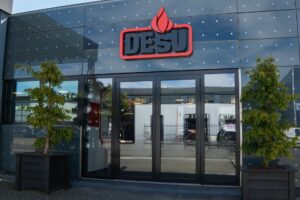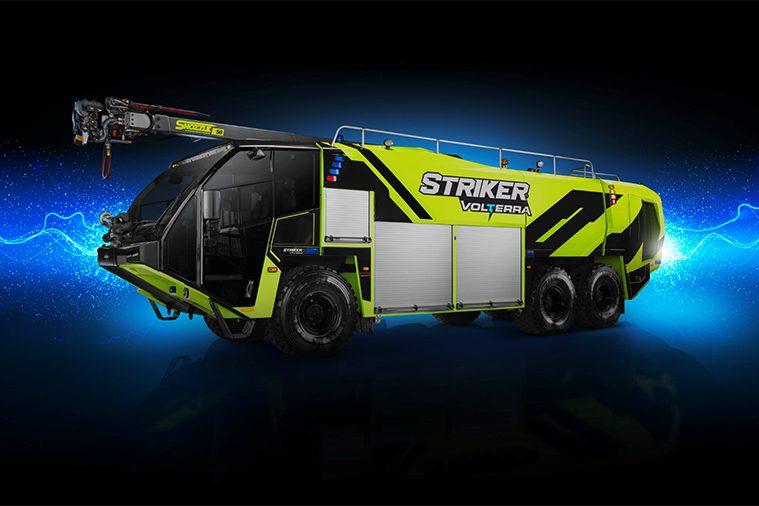 Prominent at Interschutz were Lenzing, the world leaders in flame resistant cellulosic manmade fibres for fire fighters and other workers in hazardous environments. The company’s principal product for the fire fighting market, Lenzing FR®, is a natural fibre derived from wood with a track record covering 30 years. It offers protection from heat and flame in a variety of applications.
Prominent at Interschutz were Lenzing, the world leaders in flame resistant cellulosic manmade fibres for fire fighters and other workers in hazardous environments. The company’s principal product for the fire fighting market, Lenzing FR®, is a natural fibre derived from wood with a track record covering 30 years. It offers protection from heat and flame in a variety of applications.
Unique thermal insulation properties combined with permanent flame resistance make Lenzing FR® a ‘heat protection fibre.’ The fibre offers protection from all kinds of heat – which see it used at foundries and smelting plants as well as by fire crew – and its properties assist in preventing heat stress and heat stroke. Metal workers who are accustomed to high levels of conductive and radiant heat as well as the possibility of convective heat combined with a risk of liquid metal splashes appreciate the fibre more than most.
In addition to protection, benefits include breathability and improved moisture management through wicking, the process by which perspiration leaves the skin’s surface and subsequent evaporation has a cooling effect. Advances by the Austrian company means that there is no longer a need to agonise over trade-offs between protection and comfort.
Similarly, personnel and safety managers do not need to worry unduly over workers not wearing protective garments since the fabric is likely to be more comfortable than regular clothes.
in tests conducted by lenzing and by external partners and standards authorities, the fibre has been shown to lower heat transfer since it carbonises.’
Staff at the Lenzing booth at Interschutz explained to Fire Buyer that their product is used in blends with other high performance fibres. As part of the outer shell of a fire fighter’s garments, the fibre brings heat protection as well as comfort due to the softer touch of the fabric.

Stability is also brought to the fabric of the fire fighter’s outfit as heat shrinkage is reduced. Medical personnel experienced in treating burns will often highlight the forearm as a problem area, usually because of the tightness of the garment. A fire fighter’s tunic must be tight around the cuff so that flames do not enter by the sleeve but this makes the forearm vulnerable to burns. The same is true of the calf area since a garment will be body-hugging around the ankles.
Regular fabrics do not carbonise but simply swell and shorten in dimensions in fire conditions. A garment with a Lenzing FR® mix has dimensional stability; it retains its proportions and carbonises, so avoiding the disintegration that is associated with fabric becoming brittle. The natural raw material used to produce Lenzing FR® is beech wood and the entire manufacturing process is monitored strictly in terms of ecological integrity.
The company can therefore be proud of its green credentials since a principal content is a renewable resource. Production of the Lenzing FR® fibre sees a halogen- free flame retardant agent incorporated into the spinning mass and the creation of an inherently flame-resistant fibre. Lenzing FR® is often introduced to overall fabric composition at just 30 percent but leads to radical improvements and does not impact on durability of the garment or the ability to apply dies and launder it regularly.
The flame retardant content is incorporated throughout the cross section of the fibre; it lasts the lifetime of the garment and is not compromised by friction in everyday use. Natural bacterio-static content even reduces problems with trapped body odour. The incorporated pigment is free from brominates and antimon-trioxides. While the most common application of the fibre is tunics, jackets and trousers…
‘Convective, conductive and radiant heat are all relevant, and the spectrum is far more complex than simple flames.’
it can also be used in protective hoods, hats, t-shirts, underwear, gloves and socks. Far from making uniform and industrial clothing unpleasant to wear, the fibre renders fabrics soft and comfortable on the skin. Lenzing FR® feels immediately cool, even after severe flame and heat exposure. Items made from a blend of the Lenzing product and other high-performance fibres offer excellent resistance to abrasion as well as resistance to liquid fuels and alkalis that can all be hazards encountered by a
fire fighter.
The incorporated fame retardant agent is free from halogens so that no toxic gases are produced on exposure to heat and flames. Anti-static properties are also of a high order and the wide-ranging improvements in comfort can help a worker focus on a task and reduce the risk of industrial injury from other factors.

Casting, re-melting and many maintenance activities are all areas where staff can benefit, and major metal producers endorse Lenzing FR® -based garments as providing optimum molten aluminium and cryolite protection. Observing crews performing timed exercises in the heat wave that accompanied the Interschutz show in Leipzig, Fire Buyer reporters quickly appreciated the importance of wickability in crew uniform. (Members of the general public at the trade fair who had not exerted themselves were being treated for heat exhaustion.)
The results of more precise observations were presented during the trade show by Professor Herfried Pessenhofer of the Medical University in Graz who has tested the physiological properties of many different fabric compositions. The following materials which are mainly used in protective clothing worn by firemen formed the test: blends of aramid and Lenzing FR®, pure cotton with a flame-resistant finish, pure aramid (more properly known as aromatic polyamide) and a blend of Modacryl and cotton. (Modacryl is a synthetic copolymer.) The aramid/Lenzing FR® fibre emerged as the clear winner of the study. Since a lower core body temperature is maintained with Lenzing FR®, the wearer has a higher performance profile.
This can be quantified at 16 watts or the ability to run for one minute longer, easily a margin that can be a life or death difference for firemen. Lenzing FR® is the only flame-resistant fibre in the marketplace that is produced in the Modal process. (The generic phrase for spinning reconstituted cellulose from beech trees.) The very highest fibre tenacity can be reached and the flame protection is permanently encased inside the fibre. By contrast, conventional flame-resistant fibres made on a viscose basis lose some of their tenacity and protective benefits during the process.
Lenzing is the world leader in the production of cellulose- based fibres. The company has a turnover of 1.25 bn and employs 6,000 people worldwide, 3,000 of these being at corporate headquarters in the town of Lenzing to the north of Lake Attersee in Austria.
Contact
Tel: + 43 7672 701 3290
Web: www.lenzing-fr.com
Email: [email protected]




































